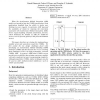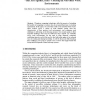218 search results - page 5 / 44 » Benefits and challenges for platform-based design |
IPPS
2007
IEEE
14 years 1 months ago
2007
IEEE
Hardware accelerators are increasingly used to extend the computational capabilities of baseline scalar processors to meet the growing performance and power requirements of embedd...
LCTRTS
2001
Springer
13 years 11 months ago
2001
Springer
When the Asynchronous Method Invocation (AMI) model was introduced into the CORBA specification, client applications benefited from the ability to invoke nonblocking two-way reque...
HUC
2004
Springer
14 years 20 days ago
2004
Springer
Ubiquitous computing technologies offer the promise of extending the benefits of computing to workers who do not spend their time at a desktop environment. In this paper, we review...
ERSA
2010
13 years 4 months ago
2010
- Partial reconfiguration (PR) enhances traditional FPGA-based high-performance reconfigurable computing by providing additional benefits such as reduced area and memory requiremen...
FCCM
2004
IEEE
13 years 11 months ago
2004
IEEE
It is valuable to identify and catalog design patterns for reconfigurable computing. These design patterns are canonical solutions to common and recurring design challenges which ...


